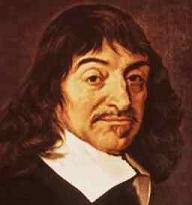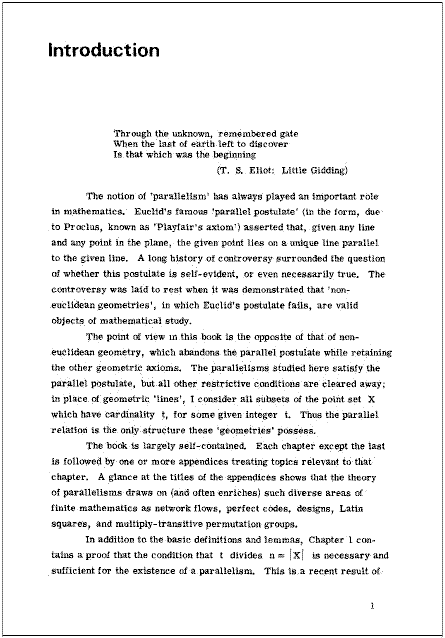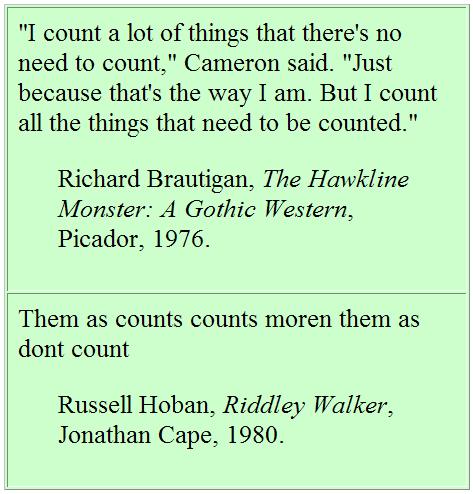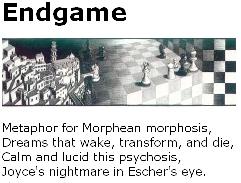See as well Correspondences.

There are many approaches to constructing the Mathieu
group M24. The exercise below sketches an approach that
may or may not be new.
Exercise:
It is well-known that …
There are 56 triangles in an 8-set.
There are 56 spreads in PG(3,2).
The alternating group An is generated by 3-cycles.
The alternating group A8 is isomorphic to GL(4,2).
Use the above facts, along with the correspondence
described below, to construct M24.
Some background —
A Log24 post of May 19, 2013, cites …
Peter J. Cameron in a 1976 Cambridge U. Press
book — Parallelisms of Complete Designs .
See the proof of Theorem 3A.13 on pp. 59 and 60.

See also a Google search for "56 triangles" "56 spreads" Mathieu.
Update of October 31, 2019 — A related illustration —

Update of November 2, 2019 —
See also p. 284 of Geometry and Combinatorics:
Selected Works of J. J. Seidel (Academic Press, 1991).
That page is from a paper published in 1970.
Update of December 20, 2019 —
This post was suggested by the two previous posts, Sermon and Structure.

Vide below the final paragraph— in Chapter 7— of Cameron’s Parallelisms ,
as well as Baudelaire in the post Correspondences :
Comme de longs échos qui de loin se confondent
Dans une ténébreuse et profonde unité….
— Baudelaire, “Correspondances “

A related image search (click to enlarge):
Epigraphs from Parallelisms of Complete Designs
by Peter J. Cameron (Cambridge University Press, 1976)
Introduction
Through the unknown, remembered gate
When the last of earth left to discover
Is that which was the beginning
(T. S. Eliot: Little Gidding)
I The existence theorem
Here the impossible union
Of spheres of existence is actual
(T. S. Eliot: The Dry Salvages)
II The parallelogram property
A condition of complete simplicity
(Costing not less than everything)
(T. S. Eliot: Little Gidding)
III Steiner points and Veblen points
You say I am repeating
Something I have said before. I shall say it again.
Shall I say it again?
(T. S. Eliot: East Coker)
IV Edge-colourings of complete graphs
And hollyhocks that aim too high
Red into grey and tumble down
(T. S. Eliot: East Coker)
V Biplanes and metric regularity
Two and two, necessarye conjunction,
Holding eche other by the hand or the arm
Whiche betokeneth concorde.
(T. S. Eliot: East Coker)
VI Automorphism groups
At the still point of the turning world. Neither flesh nor fleshless;
Neither from nor towards; at the still point, there the dance is,
But neither arrest nor movement.
(T. S. Eliot: Burnt Norton)
VII Resolutions and partition systems
… fiddle with pentagrams
Or barbituric acids, or dissect
The recurrent image into pre-conscious terrors .. .
(T. S. Eliot: The Dry Salvages)
In "Notes on Finite Group Theory"
by Peter J. Cameron (October 2013),
http://www.maths.qmul.ac.uk/~pjc/notes/gt.pdf,
some parts are particularly related to the mathematics of
the 4×4 square (viewable in various ways as four quartets)—
Cameron is the author of Parallelisms of Complete Designs ,
a book notable in part for its chapter epigraphs from T.S. Eliot's
Four Quartets . These epigraphs, if not the text proper, seem
appropriate for All Saints' Day.
But note also Log24 posts tagged Not Theology.
From an arXiv preprint submitted July 18, 2011,
and last revised on March 11, 2013 (version 4):
"By our construction, this vector space is the dual
of our hypercube F24 built on I \ O9. The vector space
structure of the latter, to our knowledge, is first
mentioned by Curtis in [Cur89]. Hence altogether
our proposition 2.3.4 gives a novel geometric
meaning in terms of Kummer geometry to the known
vector space structure on I \ O9."
[Cur89] reference:
R. T. Curtis, "Further elementary techniques using
the miracle octad generator," Proc. Edinburgh
Math. Soc. 32 (1989), 345-353 (received on
July 20, 1987).
— Anne Taormina and Katrin Wendland,
"The overarching finite symmetry group of Kummer
surfaces in the Mathieu group M 24 ,"
arXiv.org > hep-th > arXiv:1107.3834
"First mentioned by Curtis…."
No. I claim that to the best of my knowledge, the
vector space structure was first mentioned by me,
Steven H. Cullinane, in an AMS abstract submitted
in October 1978, some nine years before the
Curtis article.
|
Update of the above paragraph on July 6, 2013—
No. The vector space structure was described by
The vector space structure as it occurs in a 4×4 array |
See Notes on Finite Geometry for some background.
See in particular The Galois Tesseract.
For the relationship of the 1978 abstract to Kummer
geometry, see Rosenhain and Göpel Tetrads in PG(3,2).
From William M. Kantor's 1978 review of Peter J. Cameron's
1976 book Parallelisms of Complete Designs—
"There are three ways an area of mathematics
can be surveyed: by a vast, comprehensive treatise;
by a monograph on a small corner of the field; or by
a monograph on a cross section."
An area of mathematics—

A small corner of the field—

A cross section—

The area— Four.
The corner— Identity.
The cross section— Window.
The three ways— December 8 ten years ago.
There is a remarkable correspondence between the 35 partitions of an eight-element set H into two four-element sets and the 35 partitions of the affine 4-space L over GF(2) into four parallel four-point planes. Under this correspondence, two of the H-partitions have a common refinement into 2-sets if and only if the same is true of the corresponding L-partitions (Peter J. Cameron, Parallelisms of Complete Designs, Cambridge U. Press, 1976, p. 60). The correspondence underlies the isomorphism* of the group A8 with the projective general linear group PGL(4,2) and plays an important role in the structure of the large Mathieu group M24.
A 1954 paper by W.L. Edge suggests the correspondence should be named after E.H. Moore. Hence the title of this note.
Edge says that
It is natural to ask what, if any, are the 8 objects which undergo
permutation. This question was discussed at length by Moore…**.
But, while there is no thought either of controverting Moore's claim to
have answered it or of disputing his priority, the question is primarily
a geometrical one….
Excerpts from the Edge paper—

Excerpts from the Moore paper—
Pages 432, 433, 434, and 435, as well as the section mentioned above by Edge— pp. 438 and 439
* J.W.P. Hirschfeld, Finite Projective Spaces of Three Dimensions, Oxford U. Press, 1985, p. 72
** Edge cited "E.H. Moore, Math. Annalen, 51 (1899), 417-44." A more complete citation from "The Scientific Work of Eliakim Hastings Moore," by G.A. Bliss, Bull. Amer. Math. Soc. Volume 40, Number 7 (1934), 501-514— E.H. Moore, "Concerning the General Equations of the Seventh and Eighth Degrees," Annalen, vol. 51 (1899), pp. 417-444.
The Secret Life of Walter Murphy
Continued from last night…
"On 1 March 07, I was scheduled
to fly on American Airlines…."
— A tale by the late Walter F. Murphy,
professor emeritus of constitutional law at Princeton
Related material:
A hymn for Murphy — "I'll Fly Away."
See also this journal on
that same date– 1 March 07— along with
From today's NY Times—

Obituaries for mystery authors
Ralph McInerny and Dick Francis
From the date (Jan. 29) of McInerny's death–
"…although a work of art 'is formed around something missing,' this 'void is its vanishing point, not its essence.'"
– Harvard University Press on Persons and Things (Walpurgisnacht, 2008), by Barbara Johnson
From the date (Feb. 14) of Francis's death–

The EIghtfold Cube
The "something missing" in the above figure is an eighth cube, hidden behind the others pictured.
This eighth cube is not, as Johnson would have it, a void and "vanishing point," but is instead the "still point" of T.S. Eliot. (See the epigraph to the chapter on automorphism groups in Parallelisms of Complete Designs, by Peter J. Cameron. See also related material in this journal.) The automorphism group here is of course the order-168 simple group of Felix Christian Klein.
For a connection to horses, see
a March 31, 2004, post
commemorating the birth of Descartes
and the death of Coxeter–
Putting Descartes Before Dehors


For a more Protestant meditation,
see The Cross of Descartes—

"I've been the front end of a horse
and the rear end. The front end is better."
— Old vaudeville joke
For further details, click on
the image below–
Notre Dame Philosophical Reviews
Today's New York Times on a current theatrical presentation of The Great Gatsby—
"Throughout the show, the relationship between what is read and its context keeps shifting, with the real world finally giving way entirely to the fictive one."
"This fella's a regular Belasco."

David Brown, producer. Brown died on Monday.
From The Diamond as Big as the Monster in this journal on Dec. 21, 2005–
"At the still point, there the dance is.” –T. S. Eliot, Four Quartets
Eliot was quoted in the epigraph to the chapter on automorphism groups in Parallelisms of Complete Designs, by Peter J. Cameron, published when Cameron was at Merton College, Oxford.
“As Gatsby closed the door of ‘the Merton College Library’ I could have sworn I heard the owl-eyed man break into ghostly laughter.” –F. Scott Fitzgerald
Related material: Yesterday's posts and the jewel in Venn's lotus.
From Peter J. Cameron's
Parallelisms of Complete Designs (pdf)–

"…the Feast of Nicholas Ferrar
is kept on the 4th December."
Cameron's is the usual definition
of the term "non-Euclidean."
I prefer a more logical definition.
Epigraphs at
Peter Cameron’s home page:

See also the epigraphs in Cameron’s
Parallelisms of Complete Designs,
entries on this date three years ago,
Russell Hoban in this journal,
and
The Hawkline Monster in this journal.
"Through the unknown,
remembered gate…."
(Epigraph to the introduction,
Parallelisms of Complete Designs
by Peter J. Cameron,
Merton College, Oxford)
"It's still the same old story…."
— Song lyric
The Great Gatsby, Chapter 6:
"An instinct toward his future glory had led him, some months before, to the small Lutheran college of St. Olaf in southern Minnesota. He stayed there two weeks, dismayed at its ferocious indifference to the drums of his destiny, to destiny itself, and despising the janitor’s work with which he was to pay his way through."
There is a link to an article on St. Olaf College in Arts & Letters Daily today:
"John Milton, boring? Paradise Lost has a little bit of something for everybody. Hot sex! Hellfire! Some damned good poetry, too…" more»
The "more" link is to The Chronicle of Higher Education.
For related material on Paradise Lost and higher education, see Mathematics and Narrative.
Exercise
Review the concepts of integritas, consonantia, and claritas in Aquinas:
"For in respect to beauty three things are essential: first of all, integrity or completeness, since beings deprived of wholeness are on this score ugly; and [secondly] a certain required design, or patterned structure; and finally a certain splendor, inasmuch as things are called beautiful which have a certain 'blaze of being' about them…."
— Summa Theologiae Sancti Thomae Aquinatis, I, q. 39, a. 8, as translated by William T. Noon, S.J., in Joyce and Aquinas, Yale University Press, 1957
Review the following three publications cited in a note of April 28, 1985 (21 years ago today):
(1) Cameron, P. J.,
Parallelisms of Complete Designs,
Cambridge University Press, 1976.
(2) Conwell, G. M.,
The 3-space PG(3,2) and its group,
Ann. of Math. 11 (1910) 60-76.
(3) Curtis, R. T.,
A new combinatorial approach to M24,
Math. Proc. Camb. Phil. Soc.
79 (1976) 25-42.
Discuss how the sextet parallelism in (1) illustrates integritas, how the Conwell correspondence in (2) illustrates consonantia, and how the Miracle Octad Generator in (3) illustrates claritas.
For the feast of
St. Francis Scott Key Fitzgerald
From Fitzgerald’s The Diamond as Big as the Ritz:
“Now,” said John eagerly, “turn out your pocket and let’s see what jewels you brought along. If you made a good selection we three ought to live comfortably all the rest of our lives.”
Obediently Kismine put her hand in her pocket and tossed two handfuls of glittering stones before him.
“Not so bad,” cried John, enthusiastically. “They aren’t very big, but– Hello!” His expression changed as he held one of them up to the declining sun. “Why, these aren’t diamonds! There’s something the matter!”
“By golly!” exclaimed Kismine, with a startled look. “What an idiot I am!”
“Why, these are rhinestones!” cried John.
From The Hawkline Monster, by Richard Brautigan:
“What are we going to do now?” Susan Hawkline said, surveying the lake that had once been their house.
Cameron counted the diamonds in his hand. There were thirty-five diamonds and they were all that was left of the Hawkline Monster.
“We’ll think of something,” Cameron said.
“A disciple of Ezra Pound, he adapts to the short story the ideogrammatic method of The Cantos, where a grammar of images, emblems, and symbols replaces that of logical sequence. This grammar allows for the grafting of particulars into a congeries of implied relation without subordination. In contrast to postmodernists, Davenport does not omit causal connection and linear narrative continuity for the sake of an aleatory play of signification but in order to intimate by combinational logic kinships and correspondences among eras, ideas and forces.”
— When Novelists Become Cubists:
The Prose Ideograms of Guy Davenport,
by Andre Furlani
“T.S. Eliot’s experiments in ideogrammatic method are equally germane to Davenport, who shares with the poet an avant-garde aesthetic and a conservative temperament. Davenport’s text reverberates with echoes of Four Quartets.”
“At the still point,
there the dance is.”
— T. S. Eliot, Four Quartets,
quoted in the epigraph to
the chapter on automorphism groups
in Parallelisms of Complete Designs,
by Peter J. Cameron,
published when Cameron was at
Merton College, Oxford.
“As Gatsby closed the door of
‘the Merton College Library’
I could have sworn I heard
the owl-eyed man
break into ghostly laughter.”
In Memory of
Guy Davenport
From the day Davenport died:

“At Merton College, Oxford,
he wrote the first thesis on Joyce
to be accepted by the university.”
From a very informative essay
on Davenport’s aesthetics:
“T.S. Eliot’s experiments
in ideogrammatic method
are equally germane to Davenport,
who shares with the poet
an avant-garde aesthetic and
a conservative temperament.
Davenport’s text reverberates
with echoes of Four Quartets.”
— Andre Furlani
“At the still point, there the dance is.”
— T. S. Eliot, Four Quartets,
quoted in the epigraph to
the chapter on automorphism groups
in Parallelisms of Complete Designs,
by Peter J. Cameron,
published when Cameron was at
Merton College, Oxford.
See also
Elegance.
|
“June dawns, July noons, August evenings over, finished, done, and gone forever with only the sense of it all left here in his head. Now, a whole autumn, a white winter, a cool and greening spring to figure sums and totals of summer past. And if he should forget, the dandelion wine stood in the cellar, numbered huge for each and every day. He would go there often, stare straight into the sun until he could stare no more, then close his eyes and consider the burned spots, the fleeting scars left dancing on his warm eyelids; arranging, rearranging each fire and reflection until the pattern was clear.” “Socialism or Death” “I’m thinking, I’m thinking!” For what it’s worth, both Bradbury and Benny are from Waukegan, Illinois. |
“Through the unknown, remembered gate….”
— T. S. Eliot, epigraph to
Parallelisms of Complete Designs, by
Powered by WordPress